Parisian Walkways: Passage Verdeau in the 9th Arrondissement

Jeffrey T Iverson takes a stroll among the flâneurs in Passage Verdeau in the ninth arrondissement to discover a world of art and antiquities evocative of the Paris of Émile Zola.
Stepping out of the Grands Boulevards métro station in the ninth arrondissement of Paris, you are immediately wrapped in the frenetic energy of one of the liveliest districts of the modern French capital, with bustling brasseries, hotels and shops as far as the eye can see.
The buzz continues as you turn up Rue du Faubourg Montmartre and walk a few hundred metres until you come upon a great entryway on the left leading into the bowels of an old building, decorated with neoclassical columns and crowned with the words PASSAGE VERDEAU. At first glance, the interior appears gloomy, but as you step inside and the sounds of the street start to melt away behind you, the corridor suddenly curves to the left and opens into a bright, arrestingly charming covered arcade. A few flâneurs stroll past the windows of boutiques hung with signs like ‘Estampes’, ‘Photographies Anciennes’ and ‘Aquarelles’, while others browse through bins of antiquarian books or stacks of prints. A 19th-century clock overlooking the passageway appears to be working properly, and yet time seems to have suddenly slowed to a crawl, while a black cat saunters across the cracked marble floor, bathed in sunlight pouring in through the towering canopy of iron and glass.

Inspecting rare finds at the Cabinet des Curieux. © JT IVERSON
The poet Louis Aragon (1897–1982), one of the leading voices of the Surrealist movement, was captivated by this very light – “la lumière moderne de l’insolite” (the modern light of the unusual), he called it. “How oddly this light suffuses the covered arcades which abound in Paris in the vicinity of the main boulevards,” he wrote in Le Paysan de Paris (1926), “a glaucous gleam, seemingly filtered through deep water, with the special quality of pale brilliance of a leg suddenly revealed under a lifted skirt.”
The other-worldly atmospheres of these passageways deeply inspired Aragon and his fellow artists, who flocked to soak them up while they could, knowing the City aimed to demolish them. In a resplendent arcade like this, Aragon couldn’t help seeing a “great glass coffin”.
And yet as fate would have it, Passage Verdeau is still standing. In fact, in its quiet way, it is teeming with life like no other passageway in the capital. While the cat from the Bistrot Verdeau lazes in the afternoon sun, a commotion is taking place inside the boutique at nº29 – the picture framing shop Atelier 29. As we step inside, the owner Denise Bechouche calls out an apology from the workshop at the back of the boutique. “We have a petite urgence!”. The cause of the emergency stands in the middle of the boutique, gazing at the walls of exquisite antique and modern picture frames of every size. He glances at his watch.
“We’re a bit down to the wire,” smiles Axel Pinaire, an art dealer for Galerie AB (14 rue de la Grange Batelière), whose 1946 Alexander Calder painting Denise and her team are fitting with a new black wood frame and white matting. A photographer from the Brussels Art Fair (BRAFA) is back at Galerie AB waiting to do a shoot of the Calder and the rest of the gallery for the 2021 edition, taking place virtually across 14 countries due to Covid. It’s an event of huge importance for the gallery, so when it came to framing their €100,000 Calder, only Atelier 29 would do. “They’ve been doing this a long time, and their work is impeccable,” says Pinaire. “Which is why the entire quartier comes here!” The ‘quartier’ Pinaire refers to is the ‘Quartier Art Drouot’ – a collective of more than two dozen art galleries and experts situated in the neighbourhood around the Hôtel Drouot auction house, just 100 metres from Passage Verdeau. “I’ve framed everything,” says Denise, who founded the Atelier 29 in 1987. “Works by Picasso, Tsuguharu Foujita, Victor Hugo… but I still am moved whenever something special comes through these doors.”

Livre Mon Ami is home to rare books. © JT IVERSON
Jean-Baptiste Maratier, who has worked for Denise since 1989, feels the same. “I get to see everything here,” he says, “photos, modern art, engravings, manuscripts from the French Revolution, medals from World War II, grand masters… You never get bored working in a place like this!”
Unfortunately, not all of Paris’s historic covered arcades have managed such a seamless transition to the modern era. “Part of what distinguishes this passageway from others, and which is the source of its charm, is that it has preserved its raison d’être,” observes Julie Maillard-Fouilleul, the owner of Galerie Maillard-Fouilleul at 11 passage Verdeau. “In the 19th century, it’s more or less this type of business that you found in Passage Verdeau, when the neighbourhood was home to the greatest art dealers and publishers of the era. To this very day, Passage Verdeau is continuing with that tradition.”
It’s an achievement all the more remarkable given that Passage Verdeau has always existed in the shadow of a more famous arcade – Passage Jouffroy. The two passageways were built between 1845 and 1846 by the same architects along the same axis, separated only by the narrow Rue de la Grange Batelière, and were the first Parisian passageways built entirely of metal and glass, with only decorative elements made from wood.

Livre Mon Ami. © JT IVERSON
Yet as Alfred Delvau noted in his 1867 Les Plaisirs de Paris, guide pratique, despite their similarities, Passage Verdeau did “not enjoy… the same vogue as its twin brother.” Why? Whereas Passage Jouffroy was built just across from the already popular Passage des Panoramas on the Grands Boulevards – a veritable carnival of attractions, cafés, and luxury hotels in the 19th century – Verdeau was far removed from the hubbub, picking up only at the end of Jouffroy’s 140 metres of shops and attractions. For this reason, Delvau declared that while Jouffroy had become a “promenade”, the 75-metre long Verdeau would never be more than a “passage”.
Yet soon after its construction, an institution arrived in the neighbourhood which would eventually allow Verdeau to find a calling all its own. In 1852, the Hôtel Drouot auction house was inaugurated at 9 rue Drouot, a stone’s throw from Verdeau’s entrance on Rue de la Grange Batelière. France had become the art market capital of the world, and Drouot was to be its new hub for the sale of fine art, antiques, and antiquities. “With the creation of Hôtel Drouot just before the Belle Époque, there was an injection of artistic energy into this neighbourhood, and Passage Verdeau would become the arcade most representative of that,” says Lutèce Federbusch, owner of the gallery and tearoom Honoré des Arts, situated at the corner of Passage Verdeau and Rue de la Grange Batelière. “When you see all the galleries and antique dealers we have today, that is the result of an artistic tradition that we have been consistently renewing since the mid-1800s, to the point that the quartier Drouot has remained one of the most important for art and antiquities in the capital.”
So vital is Drouot to the dynamic of the district, that when the auction house had to close from 1976 to 1980 for renovations, Verdeau almost went under. “I was a little girl when my mother founded our gallery here in 1978, so I watched this passageway evolve through the years,” recalls Julie, of Galerie Maillard-Fouilleul. “For a time it was a passageway in despair; many boutiques closed, and it was quite sad, almost squalid. But after Drouot reopened, bit by bit the art dealers returned to the neighbourhood, and I saw Passage Verdeau reborn with its historic vocation, as a passageway full of boutiques dedicated to art and antiquities.”
- The entrance to Passage Verdeau. © JT IVERSON
- Honore des Arts. © JT IVERSON
- Julie Maillard-Fouilleul with a rare signed lithograph by Bernard Buffet. Photo: © JT IVERSON
- Passage Verdeau. © JT IVERSON
- Atelier 29. © JT IVERSON
Today, Passage Verdeau boasts more than a half dozen addresses dedicated to the arts. Besides the transporting gallery Honoré des Arts and that of Maillard-Fouilleul – a renowned specialist of l’estampe, or prints such as engravings, woodblocks and lithographs – there’s also Galerie Sophie Marcellin at nº20, founded in 1987 and offering a unique collection of drawings, paintings or sculptures by travelling artists of the 19th and 20th centuries, while at nº19, Galerie Amicorum, founded in 1995, presents an evolving collection of some 1,500 drawings, watercolours and oils from the 16th to the 20th century. At nº28, Galerie Hervé Péron specialises in figurative paintings from the 1890s to 1950s, including the Breton schools of post-impressionist and modern artists who worked in Pont-Aven and Brittany from 1880 to the 1940s.
Finally, since its earliest days, Passage Verdeau has also been a destination for bibliophiles, who continue to flock here for its antiquarian book dealers, such as Librairie Farfouille at nº 27, Santon at nº18, and Livre Mon Ami at nº24. “The passageway has become a destination for collectors of all kinds today, thanks to this great diversity of galleries and antiquarian bookshops,” says Thierry Ruby, owner of Le Cabinet des Curieux at nº12, a gallery that encapsulates the arcade’s allure. A veritable tour du monde of art, natural history and ethnography, from antique Japanese dolls and African fetish statues, to ancient paintings, it’s a universe highly evocative of André Breton’s Surrealist collection of art and artefacts (today exhibited at the Pompidou Centre), making it a perfect fit for Passage Verdeau.

Passage Verdeau. Photo: © JT IVERSON
After all, it was here in November of 1870 that a tubercular artist named Isidore Ducasse came to visit the bookseller Gabrie, at 25 Passage Verdeau, to have two volumes of poetry printed at his expense. It was his last attempt to reach an audience, having failed to find a publisher for his first book, the poetic novel Les Chants de Maldoror (The Songs of Maldoror), written under the nom de plume Le Comte de Lautréamont. Days later, he was found dead in his hotel around the corner on Rue du Faubourg Montmartre. He was 24. Four years later, Les Chants de Maldoror was finally published. In the early 1900s, Lautréamont would become the patron saint of Surrealism after Louis Aragon and André Breton discovered his novel and the phrase which came to embody their movement’s aesthetic: “as beautiful as the random encounter between an umbrella and a sewing-machine upon a dissecting-table.”
Aragon and Breton thereafter began gathering their friends in a café in the Passage de l’Opéra, just to the west of Hôtel Drouot, preferring the wilted-rose-like beauty of the arcade over the bustling artistic scene of Montparnasse. As Aragon wrote in Le Paysan de Paris: “Although the life that originally quickened them [Paris’s arcades] has drained away, they deserve, nevertheless, to be regarded as the secret repositories of several modern myths: it is only today, when the pickaxe menaces them, that they have at last become the true sanctuaries of a cult of the ephemeral…”. In 1925, the pickaxes found their mark, and Passage de l’Opéra was among those demolished. But Passage Verdeau survived. How? As Julie Maillard-Fouilleul puts it: “It may not be as elegant or popular as other arcades, but it’s the lost Paris of Émile Zola – it’s a passageway that has preserved its soul.”

Honoré des Arts. Photo: © JT IVERSON
HONORÉ DES ARTS
6 rue de la Grange Batelière
Tel. +33 6 01 30 30 38
Honoré des Arts is a remarkable generalist gallery, at once open-minded and all-inclusive. From 1,000-year-old African earthenware and Chinese porcelain vases, to drawings from the Dutch Golden Age and French Belle-Époque decorative sculptures, Honoré des Arts offers works from every era and continent in a relaxed, elegant showroom that also doubles as a transporting tearoom in normal times.
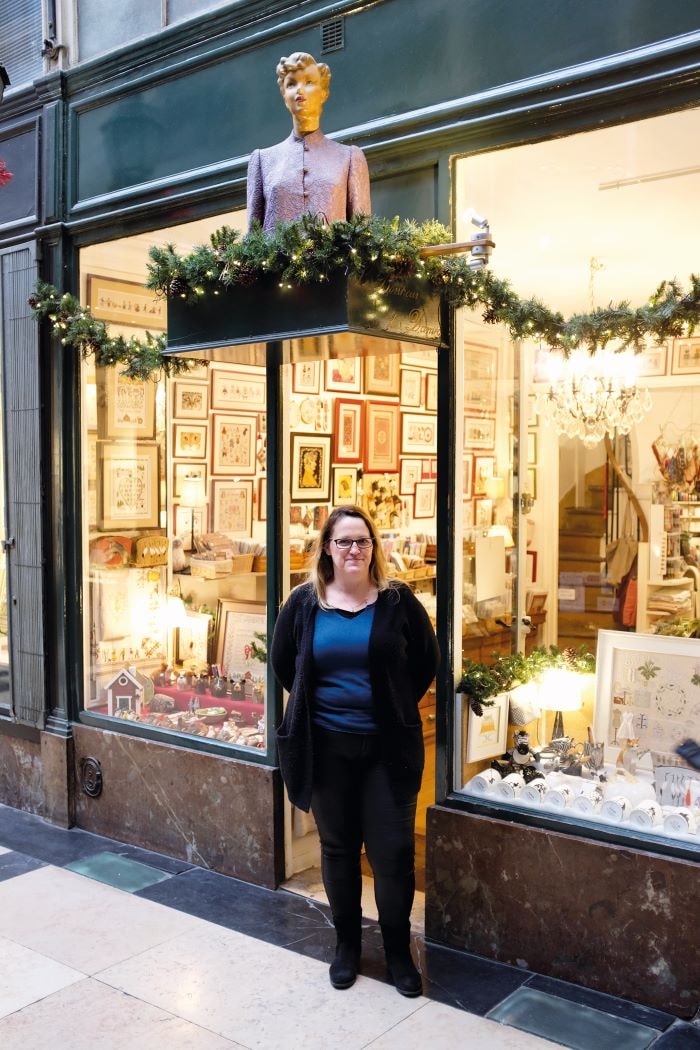
Le Bonheur des Dames. Photo: © JT IVERSON
LE BONHEUR DES DAMES
8 passage Verdeau
Tel. +33 1 45 23 06 11
Named after Zola’s 1883 novel set in a Parisian department store (in English, The Ladies’ Paradise), this boutique is a haven for lovers of decorative embroidery, sewing and knitting. A creator of original designs since 1979, Le Bonheur des Dames offers beautiful cross-stitching and embroidery kits for wall hangings, tablecloths and more, as well as quality French haberdashery supplies.
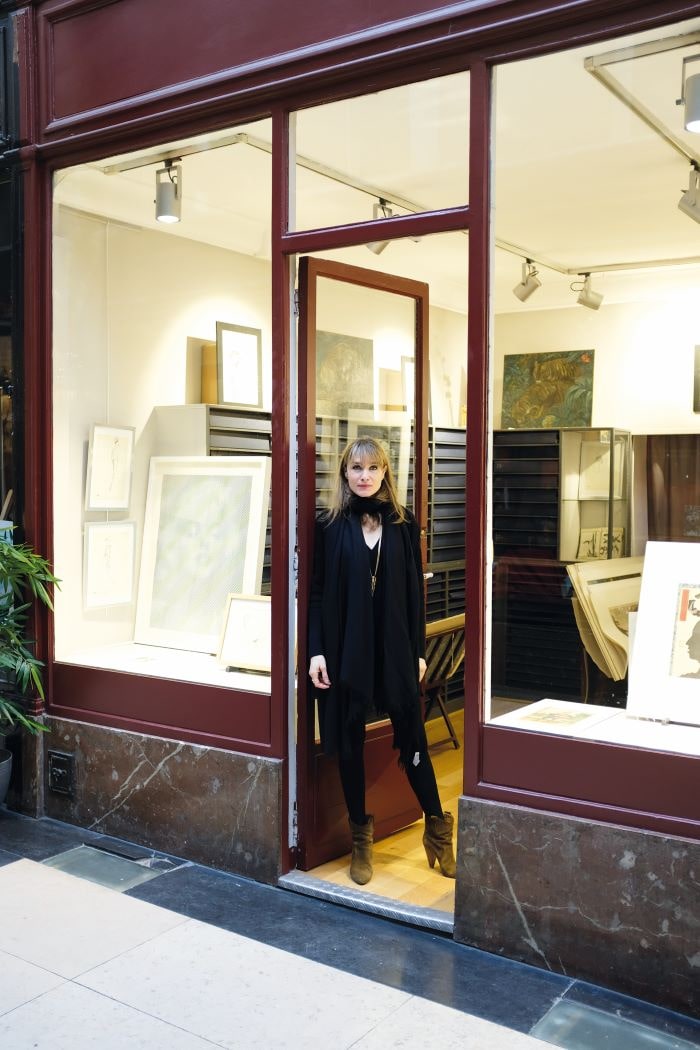
Galerie Maillard-Fouilleul. Photo: © JT IVERSON
GALERIE MAILLARD-FOUILLEUL
11 passage Verdeau
Tel. +33 1 42 46 53 20
For two generations, this gallery has celebrated the beauty and diversity of estampes – art prints of every era and technique, from engraving to lithography. Whether its a 19th-century Japanese woodcut print or a signed lithography by a famous Op-Art artist, Maillard-Fouilleul is a treasure trove of passionately curated images guaranteed to delight.
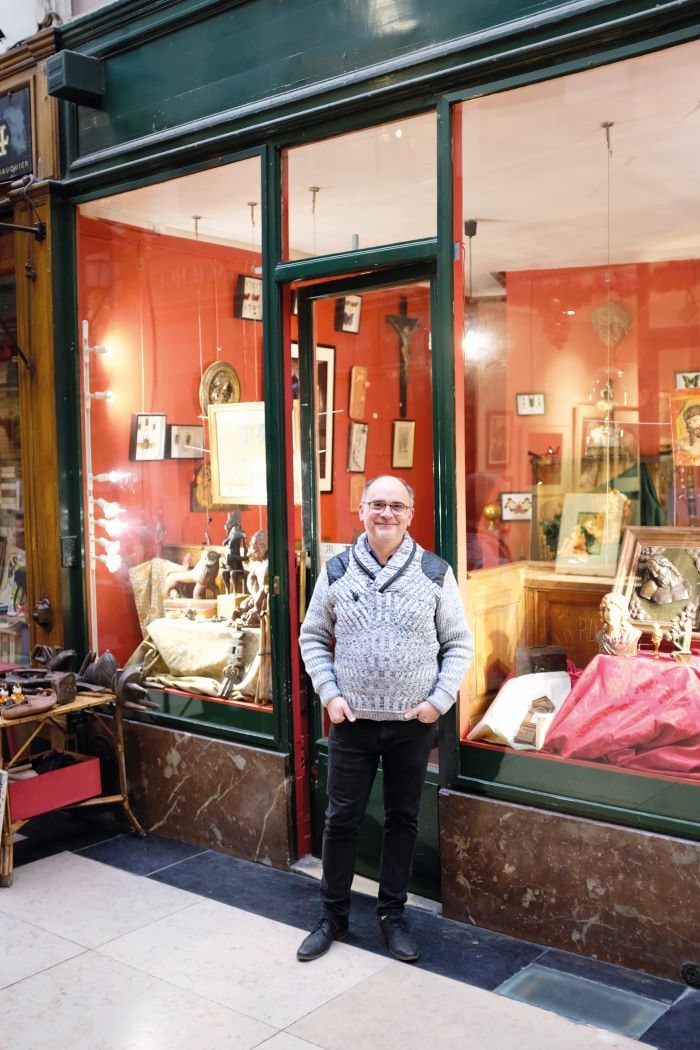
Le Cabinet des Curieux. Photo: © JT IVERSON
LE CABINET DES CURIEUX
12 passage Verdeau
Tel. +33 1 44 83 09 57
This matchbox-sized gallery is named after the ‘cabinets of curiosity’ of old – collections of antiquities, paintings, relics and wonders of the natural world which fascinated European society before the advent of museums. Offering antiques and artworks of both beauty and strangeness from around the globe, it’s a window into the fascinating mind of art collector Thierry Ruby.
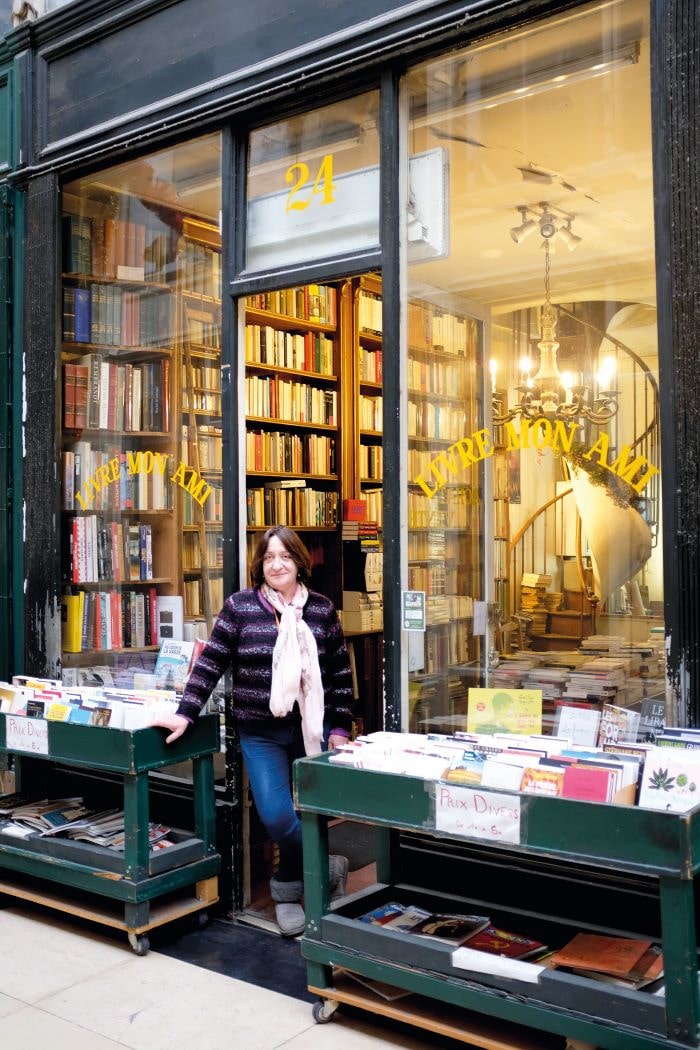
Livre Mon Ami. Photo: © JT IVERSON
LIVRE MON AMI
24 passage Verdeau
Tel. +33 1 48 24 18 71
In a passageway with multiple alluring antiquarian bookshops, Livre Mon Ami boasts a special 19th-century charm, with its timeworn spiral staircase, chandelier, and towering wooden bookcases crammed with gilded tomes. Whether you’re looking for a century-old edition of Proust’s In Search of Lost Time or a used copy of a recent bestseller, this bouquiniste has literary pearls for everyone.
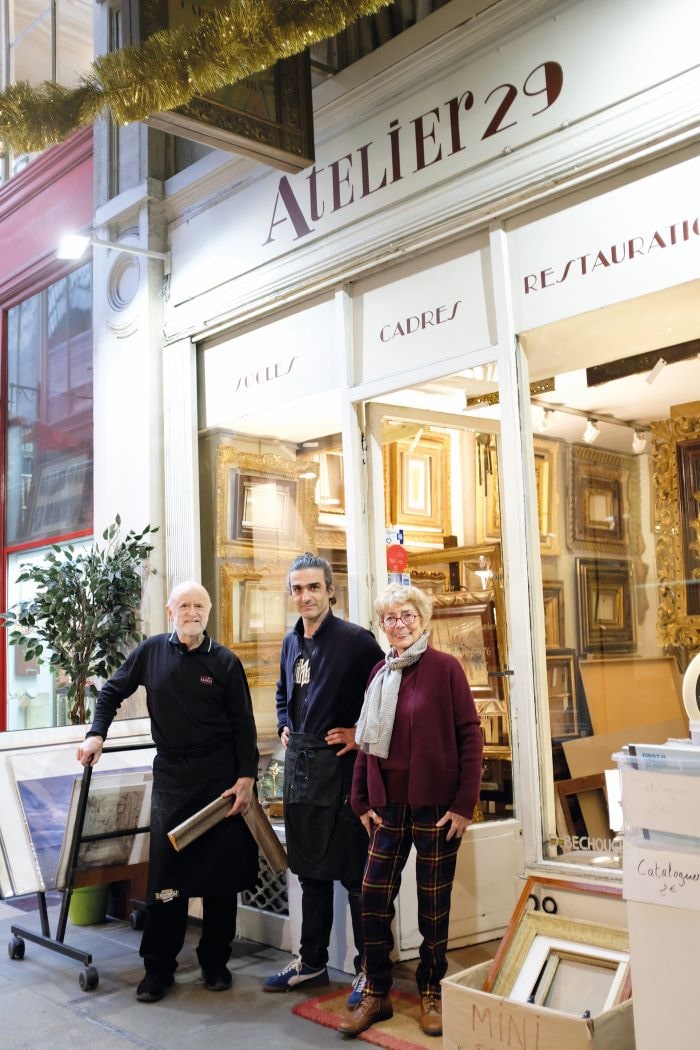
Atelier 29. Photo: © JT IVERSON
ATELIER 29
29 passage Verdeau
Tel. +33 1 42 46 60 76
Since 1987, Denise Bechouche and her team at Atelier 29 have gained renown as the top framing workshop in the Drouot art district. They restore antique frames, boast a vast collection of their own from every era, and create made-to-measure models to offer the perfect frame for any artwork. And when she’s not in the workshop, Denise is exhibiting works by current artists in her charming boutique.
From France Today Magazine
Share to: Facebook Twitter LinkedIn Email
More in art gallery, book shops, boutiques, Paris shopping, Paris street
Leave a reply
Your email address will not be published. Required fields are marked *

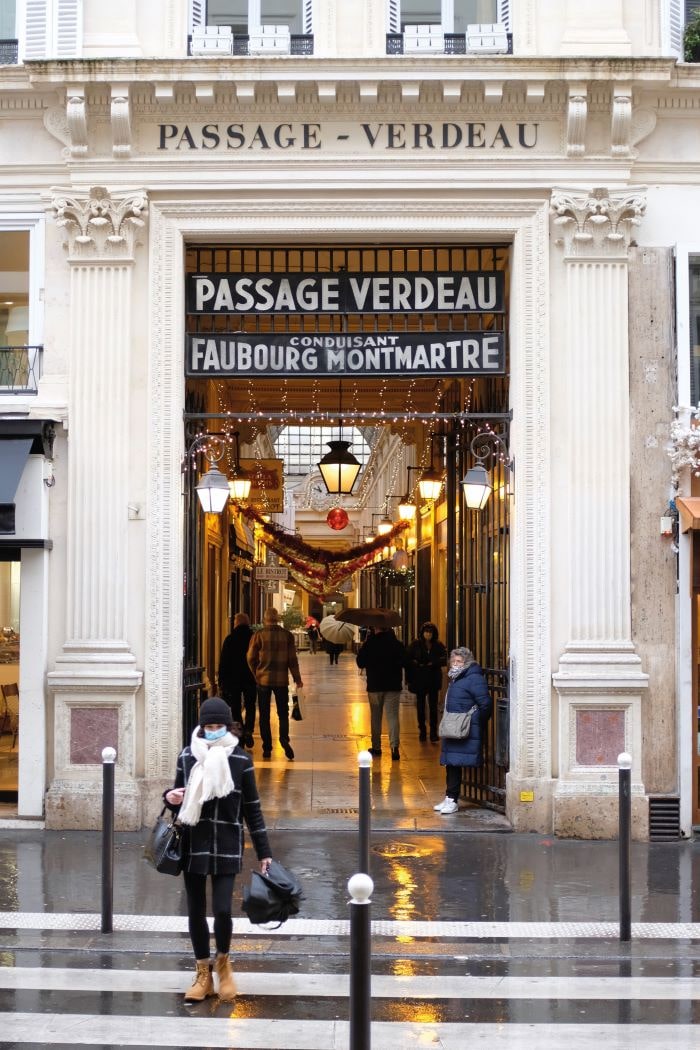

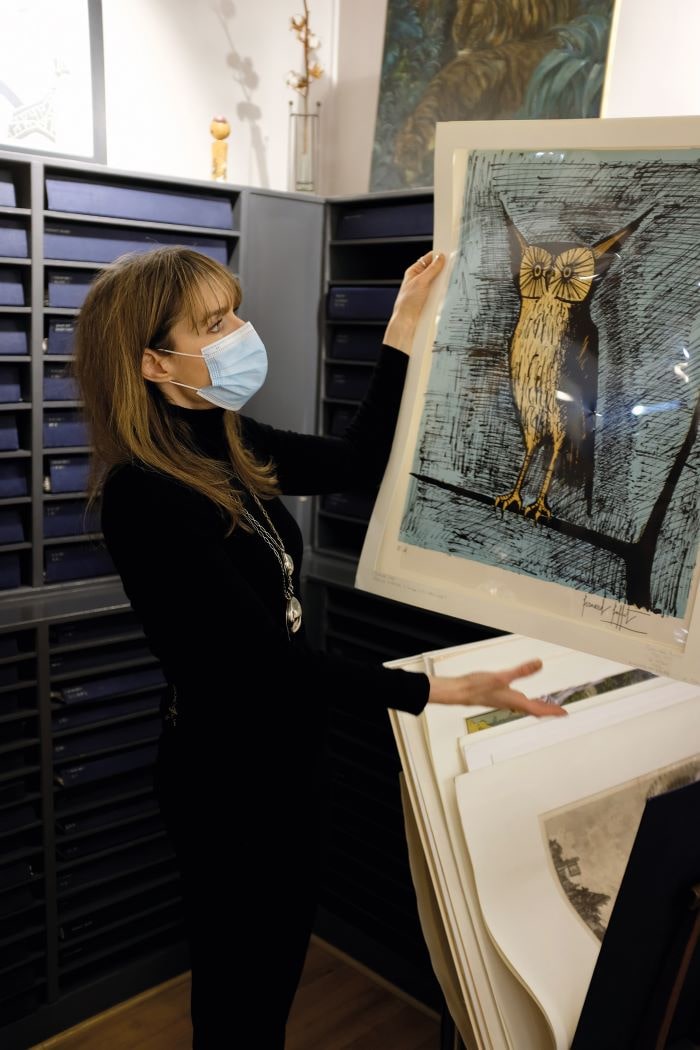





REPLY
REPLY
REPLY